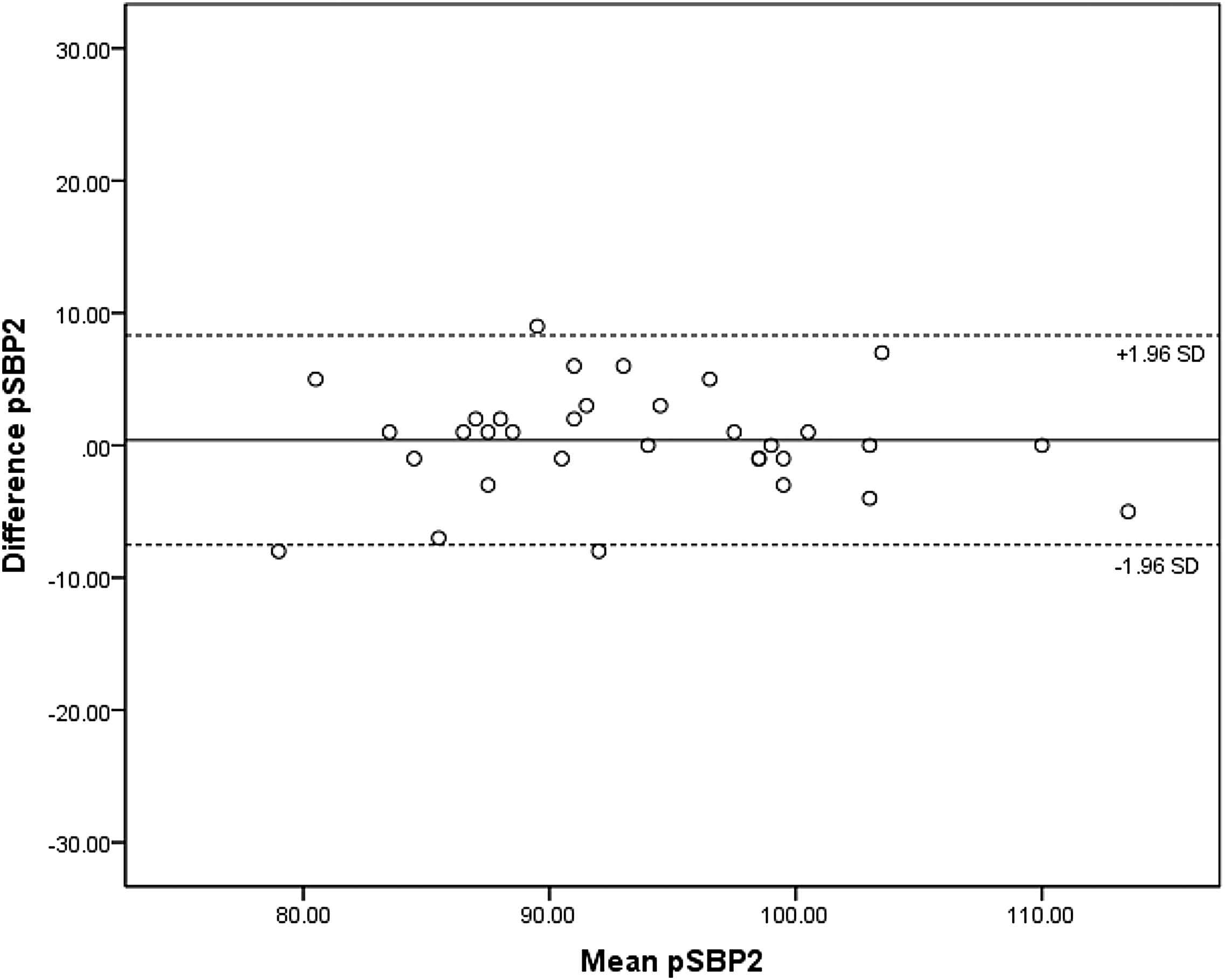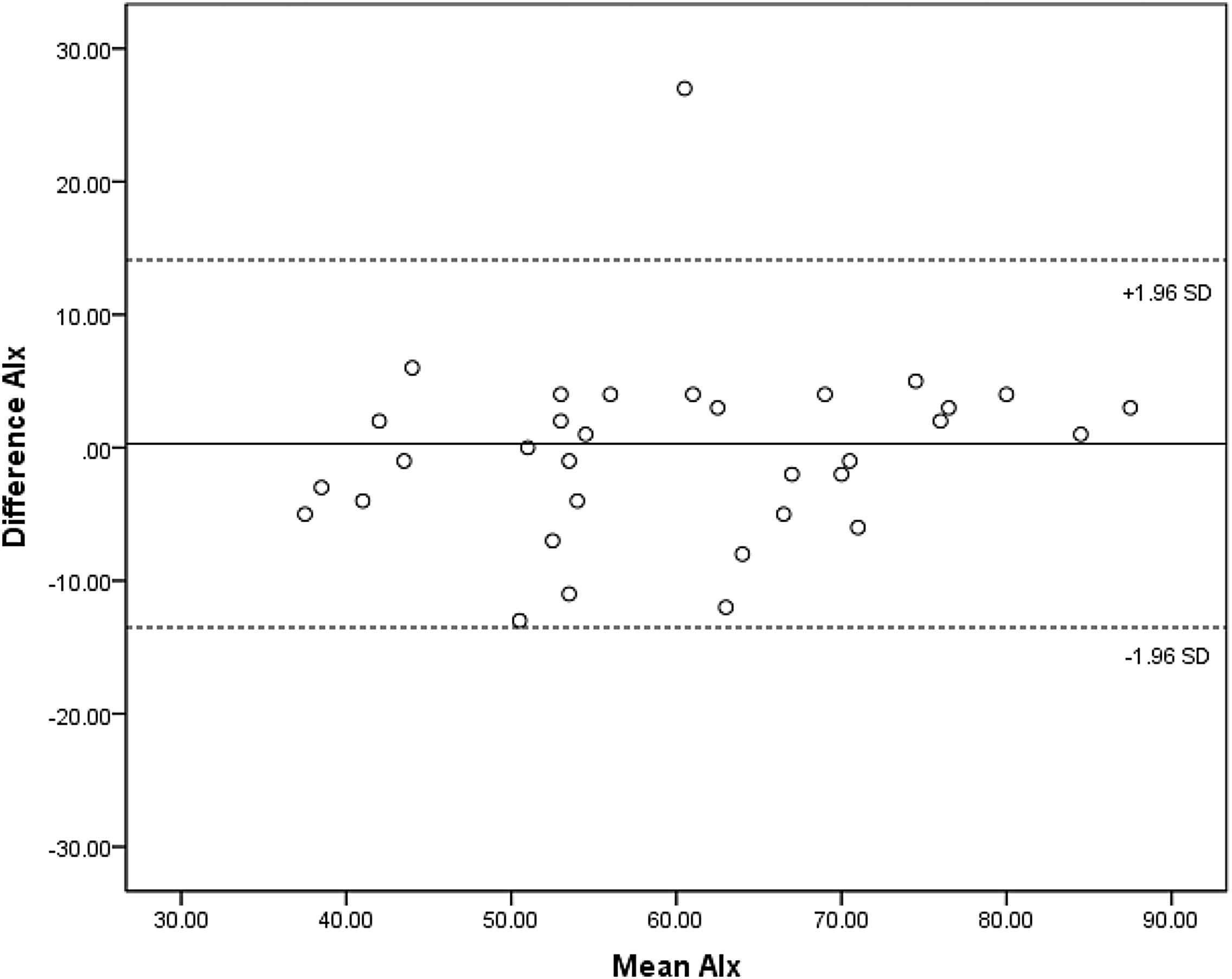Repeatability measurements of second systolic shoulder of the radial waveform and peripheral augmentation index with the OMRON HEM-9000AI device in a sample of young Mexican subjects
- DOI
- 10.1016/j.artres.2016.02.002How to use a DOI?
- Keywords
- Central aortic pressure; Central systolic blood pressure; Second systolic shoulder of the radial waveform; Peripheral augmentation index
- Abstract
The development of non-invasive technology to perform pulse wave analysis and accurately determine central blood pressure has facilitated the study of central blood pressure as a physiologic and biomarker parameter. Central systolic blood pressure (cSBP) has been shown to be significantly associated with adverse outcome such as mortality and associated with adverse outcome. One of the most commonly evaluated features of the arterial pressure waveforms is augmentation index (AIx). Nowadays, there are multiple devices that have been developed for calculate AIx at peripheral arteries. The aim of our study was to assess the repeatability measurements of second systolic shoulder of the radial waveform (pSBP2) and peripheral augmentation index (pAIx) using the OMRON HEM-9000AI. 36 young subjects were studied. The paired t student test showed no significant difference. The mean difference between the two consecutive measures of pSBP2 was 0.3 ± 4; P = 0.58, pAIx (0.3 ± 7; P = 0.80) and pAIx75 (0.5 ± 6.6; P = 0.62). This study demonstrates good repeatability and reliability of this method in our study population, compared to other populations the variability between measurements.
- Copyright
- © 2016 Association for Research into Arterial Structure and Physiology. Published by Elsevier B.V. All rights reserved.
- Open Access
- This is an open access article distributed under the CC BY-NC license.
Introduction
The development of noninvasive technology for the pulse wave analysis has facilitated the study of arterial stiffness parameters as subclinical biomarkers.1 The peripheral systolic blood pressure (pSBP) does not adequately reflect the value of the central systolic blood pressure (cSBP), which is considered one of the most important predicting factors regarding the development of future cardiovascular disease.2–4 After the development of devices that could calculate cSBP from the peripheral blood pressure waveform, cumulative evidence has demonstrated that cSBP is an important predictor of cardiovascular risk.5
cSBP may also be estimated from the peripheral pressure waveform without the use of a transfer function.6 Previous studies have demonstrated a strong correlation between pSBP2 and ascending aortic systolic pressure using invasive high-fidelity sensors and that can be used as an equivalent of invasively measured cSBP.7,8 On the other hand, augmentation index (AI) is an index of wave reflection, is an indirect parameter of arterial stiffness and it is defined as the ratio of the height of the late systolic shoulder/peak to that of the early peak/shoulder. Peripheral augmentation index (pAIx) is obtained directly from pSBP2 and it is closely related to central AI. Different prevalence of cardiovascular risk factors among races has been proved, being African Americans the ethnic group most studied and where earlier vascular changes like circadian blood pressure patterns,9 AI, cSBP and carotid intima-media thickness are observed compared to European American.10 Being race and age the main factors that could affect blood pressure variability11. At the present time it has not been reported yet repeatability studies in Mexican population to assess of the reliability of non-invasive estimation of pSBP2 and AI.
Aims
The aim of this study is to evaluate the repeatability of second systolic shoulder of the radial waveform (pSBP2) and peripheral augmentation index (pAIx) in a sample of young healthy Mexican subjects.
Methods
Thirty-six healthy subjects (20 men and 16 women) were included in the study. Previously, all patients were advised to not consume alcoholic or caffeinated beverages for at least 12 h prior to the study. Patients rested for 15 min before the measurements. The pulse wave analysis was performed by applanation tonometry with the OMRON HEM-9000AI device (Omron Healthcare, Kyoto, Japan). This device calculates the cSBP, pSBP2, systolic peripheral brachial blood pressure (pSBP), diastolic peripheral brachial blood pressure (pDBP, pAIx and peripheral augmentation index adjusted in 75 beats per minute (pAIx75). The device consists of a tonometric sensor with an integrated brachial cuff. This method permits a best approach to obtain the pulse wave morphology and the peripheral brachial BP. The pSBP2 is calibrated with the measurement of pSBP. To assess short term repeatability, we made the measurements with a time delay of 1 min, without taking off the tonometer between these. All measurements were performed by one cardiovascular specialist.
Statistical analysis
We calculated the mean difference ± standard deviation (SD) of the two consecutive measurements pSBP2, AIx and pAIx75. The coefficient of repeatability was calculated as 1.96*SD (within-subject standard deviation), it reflects the maximum difference likely to expect between measures12 and Bland–Altman plots for agreement. Analysis was performed using SPSS v.20.0 (IBM Corp., Armonk, NY, USA).
Results
The paired t students test showed no significance between measurements. Table 1 summarizes mean values and difference between measurements and coefficients of repeatability. The mean difference of the first and second measurements were 0.3 ± 4; P = 0.58; (95% CI, 0.26 to 4.3), 0.3 ± 79; P = 0.80; (95% CI, −2.8 to 2.1) and 0.5 ± 6.6; P = 0.62; (95% CI, −2.9 to 1.7) for pSBP2, pAIx and pAIx75, respectively. The repeatability coefficient was 8 mmHg, 13.7% and 12.9% for pSBP2, pAIx and pAIx75. The latter showed a better coefficient compared to pAIx. The analysis of the two techniques shows the agreement between measurements (Figs. 1 and 2).
| 1st reading | 2nd reading | MD ± SD | 95% CI | P value | RC | |
|---|---|---|---|---|---|---|
| pSBP2 (mmHg) | 93.7 ± 8.2 | 93.3 ± 8.3 | 0.3 ± 4 | 0.26 to 4.3 | 0.58 | 8 mmHg |
| pAIx (%) | 59.9 ± 14.4 | 60.2 ± 13.1 | 0.3 ± 7 | −2.8 to 2.1 | 0.80 | 13.7% |
| pAIx75 (%) | 58.3 ± 14.8 | 58.9 ± 13.8 | 0.5 ± 6.6 | −2.9 to 1.7 | 0.62 | 12.9% |
MD = mean difference, CI = confidence intervals, SD = standard deviation, RC = repeatability coefficient.
Difference between measurements and repeatability coefficient.

Bland–Altman plot showing the agreement between pSBP2 consecutive measurements and no systemic bias. The dotted line represents the limits of agreement ±2SD. The solid line represents the mean difference.

Bland–Altman plot show the agreement between of AIx of consecutive measurements and no systemic bias. The dotted line represents the limits of agreement ±2SD. The solid line represents the mean difference.
Conclusion
As arteries stiffen, the velocity of the pulse wave and the amplitude of the reflected wave both increase.8 This leads to a change in the shape of the pressure waveform and augmentation of central systolic pressure. Thus, cSBP and pAIx both provide useful information concerning arterial stiffness, which cannot be readily obtained from assessment of peripheral blood pressure.
According to our measurements, the results demonstrate that pSBP2 and AIx are repeatable methods, and this device do not require prolonged periods of training. This automated technique is easy to use, is not operator-dependent, and guarantees good reliability and repeatability, as shown. This method enables us to measure cSBP with ease, it could contribute to the further progress of studies on causal relationships between cSBP and cardiovascular diseases and also showed that this method can be used in large observational studies and in any kind of centres focused in arteriosclerosis research. Our study demonstrates good repeatability and reliability of this method in our study population, compared to other populations the variability between measurements is very similar.13
Conflict of interest
The authors declare that they have no competing interests.
Grant support
None.
References
Cite this article
TY - JOUR AU - Carlos G. Ramos AU - Guillermo A. Alanis AU - Fernando Grover AU - David Cardona AU - Mayra Jimenez AU - Victor Guzman AU - Patricia Quezada AU - Sara Pascoe AU - Leonel Garcia AU - Sylvia E. Totsuka AU - Ernesto G. Cardona PY - 2016 DA - 2016/02/19 TI - Repeatability measurements of second systolic shoulder of the radial waveform and peripheral augmentation index with the OMRON HEM-9000AI device in a sample of young Mexican subjects JO - Artery Research SP - 6 EP - 9 VL - 14 IS - C SN - 1876-4401 UR - https://doi.org/10.1016/j.artres.2016.02.002 DO - 10.1016/j.artres.2016.02.002 ID - Ramos2016 ER -
